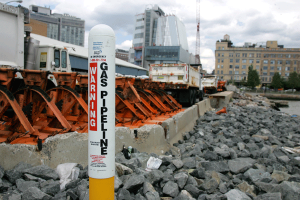The Spectra pipeline was finished and launched nearly seven months ago. The pipeline runs underneath the Gansevoort Peninsula into Manhattan, and it now delivers millions of cubic liters of natural gas to homes throughout New York City.
While New York residents certainly need access to gas, many are concerned with the health related problems the pipeline poses, or more specifically it’s link to radon.
An increasing group of opposed parties including medical experts, administrators, residents and state legislators are worried about the presence of a deadly gas called radon, which they believe is being emitted at dangerously high levels thanks to the pipeline. In fact, the concern has been so high that many protests against the pipelines construction were launched long before it was opened for use.
If you don’t already know, Radon is the second leading cause of lung cancer in the United States. It is actually the number one leading cause in non-smokers. More than 21,000 lung cancer deaths each year across the country can be attributed to radon exposure. Worse yet, the deadly gas is tasteless, odorless and colorless. For years, it has been documented that radon is associated with natural gas.
The Federal Energy Regulatory Commission (FERC) felt that the levels of radon seeping into New York Homes from the pipeline were not high enough for concern. Thus, the pipeline was constructed and soon activated for use.
The Spectra Gas Pipeline’s Link to Radon
However, many parties feel that the health risks associated with radon and exposure to it should not go ignored. One of those parties is New York State assembly member, Linda Rosenthal. Rosenthal introduced a bill last year that would require constant monitoring of New York’s natural gas delivery locations. This would help ensure that the radon released stays below dangerous levels. Obviously, the Spectra pipeline is part of that strategy, meaning it too would be monitored.
According to the United Nations’ World Health Organization, radon levels being released should not exceed 2.7 pCi/L of gas. Adversely, the US EPA recommends taking action in a residence if levels are found to exceed 4.0 pCi/L.
Rosenthall’s bill would require gas companies to keep a close eye on the radon levels being released – keeping them below the recommended limit – otherwise they would incur a fine of $25,000 per day. If an exit point is found to exceed the recommended limit, the party in question must turn off the gas supply and remedy the issue – if they refuse to act that’s where the fine would come into play.
An assembly hearing took place on May 9 that involved testimony from more than a handful of experts on radon. Representatives from the affected gas providers such as Con Ed did not show up, and instead declined a public appearance.
Rosenthall was not happy with the move, saying that companies like Con Ed clearly don’t have NY residents best interests’ at heart.
“Despite all our best efforts, [those utility companies] have refused to participate in today’s discussion. To say that I’m disappointed is an understatement. They deprive the public of the opportunity to learn more about the process and to have a lively discussion. Their actions cannot and will not hide the fact that there is no statewide monitoring system in place to deal with radon levels present in the natural gas that’s delivered to our homes. They have a vested interest in ensuring that the public is safe, and that’s why we’re holding this hearing today.”
The hearing did have some kind of effect on the community, however. Rosenthall’s bill moved forward on May 13, after being passed by the Assembly’s Committee on Health. Unfortunately, that’s just the first step and it has further to go.
You can read more about the Spectra gas pipeline and its link to radon at the source listed below.
Via: Chelsea Now



